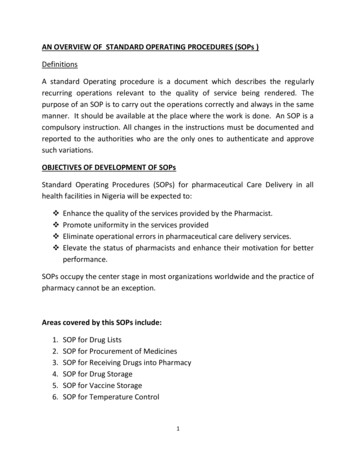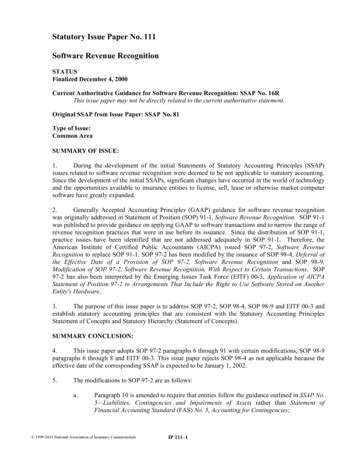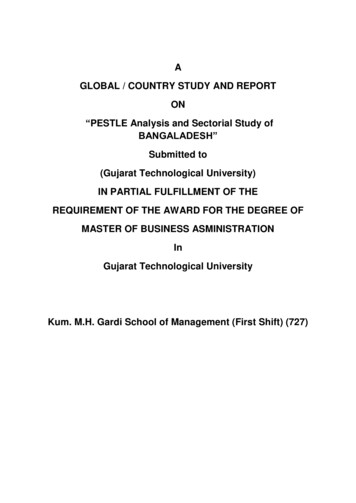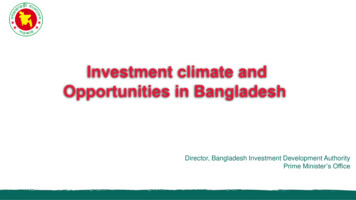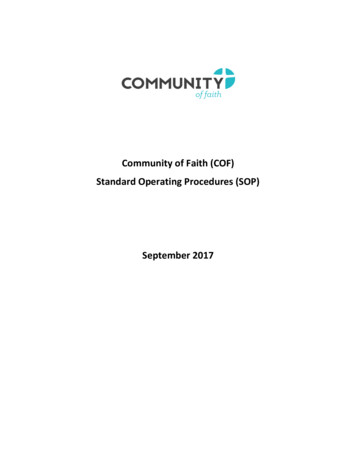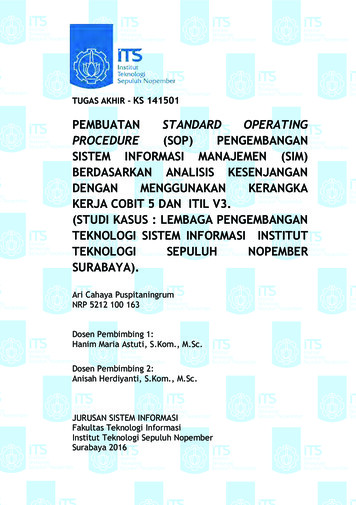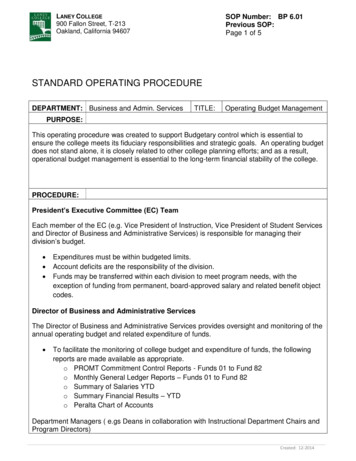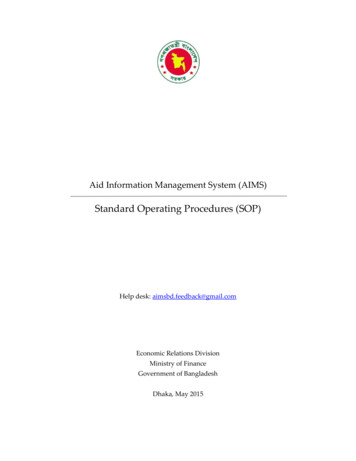
Transcription
Aid Information Management System (AIMS)Standard Operating Procedures (SOP)Help desk: aimsbd.feedback@gmail.comEconomic Relations DivisionMinistry of FinanceGovernment of BangladeshDhaka, May 2015
Table of ContentsPage1.0Introduction . 11.1Background . 11.2International aid transparency standards . 11.3Purpose of the SOPs . 22.0About Bangladesh AIMS . 32.1Objective of AIMS . 32.2What are the benefits of an AIMS? . 32.3What can Bangladesh AIMS not do? . 43.0Data Management . 63.1Overall roles and responsibilities . 63.2Responsibility for data entry . 83.3Responsibility for data management and data validation . 93.4Data entry process . 104.0Definition of key terms used in Bangladesh AIMS . 10ii Page
1.0Introduction1.1BackgroundForeign aid plays an important role in Bangladesh, providing between 30 and 40% ofthe resources for the annual development Programs in the past years. A number ofassessments have come to the conclusion that the development assistance provided bya wide range of partners should be better coordinated, as well as more harmonizedand aligned with national priorities and systems, in order to result in greater benefitsfor the country.A crucial precondition for enabling the Government of Bangladesh to coordinateDevelopment Partners and manage aid flows effectively is the availability of accurateand timely aid data, as well as the ability of government staff to analyze the data andpackage and present it in a way that allows informing and influencing decision‐making.Therefore, under the 2010 Joint Cooperation Strategy (JCS) and the 2012‐2014 JCSaction plan, government and 18 development partners committed to “strengtheningaid transparency and aid information management capacities by developing a suitableIT application to track all aid flows ( )”In order to strengthen aid coordination and aid management, better facilitate theeffective implementation of foreign‐aided projects and to enhance aid transparency,ERD has developed a web based Aid Information Management System (AIMS). Thiswas done with assistance of the project “Strengthening Capacity for Aid Effectivenessin Bangladesh” supported by Australian Aid, Denmark, DFID and UNDP.1.2International aid transparency standardsThrough the main international agreements on aid effectiveness and developmenteffectiveness (Paris Declaration of 2005, Accra Agenda for Action of 2008 and BusanPartnership of 2011, Addis Ababa 2015), development partners and aid recipientgovernments made the following commitments: Donors commit to providing regular, transparent, forward‐looking andcomprehensive information on all aid flows Recipient countries are to use this information for comprehensive budget reportsto their legislatures and citizens, for accounting and audit Establishing aid information management systems at the country level andstrengthen capacities of all relevant stakeholders to make better use of thisinformation in decision‐making and promote accountabilityBangladesh AIMS: Standard Operating Procedures1Page
These international agreements have been endorsed by the vast majority of globaldevelopment actors: 158 countries are signatory to Busan, including all OECD DACmember states. All major international organisations are signatory to Busan, as well asthe NGOs which are internationally active in the field of aid transparency anddevelopment effectiveness, joint in an umbrella federation called “Better Aid”.In addition, a group of donors, recipient governments and CSOs started the“International Aid Transparency Initiative” in 2008. IATI has developed and iscontinuously expanding an international standard for aid information throughcommon definitions and common electronic formats for data. 210 countries andorganisations are now publishing their data using IATI standards and the numbergrows steadily1. IATI also promotes knowledge exchange around AIMS and otherODA related data bases around the world. IATI is currently co‐chaired by theNetherlands and Bangladesh.2 The Bangladesh AIMS is IATI compliant.In addition, a number of civil society specific agreements on developmenteffectiveness and aid transparency have been reached by civil society organisations,most notably the “Istanbul CSO Development Effectiveness Principles” (2010) and the“Siem Reap CSO Consensus” (2011) These CSO agreements commit to transparency,mutual accountability, increasing and improving flow for information among allstakeholders.1.3Purpose of the SOPsThe purpose of this Standard Operating Procedure (SOP) is to establish clear andconsistent procedures for aid information reporting and management for theGovernment of Bangladesh and Development Partners. This document outlinesinformation on the specific definitions and classification used in the Aid InformationManagement System. It also delineated roles and responsibilities of both theGovernment of Bangladesh and its Development partners so that the AIMS isroutinely kept up‐to‐date. The SOP is a living document and can be reviewed whennecessary. The SOPs are complemented by an AIMS user manual and AIMSadministrator manual, providing detailed guidance on how to upload data.122014 IATI annual report2013‐2015 mandateBangladesh AIMS: Standard Operating Procedures2Page
2.0AAboutBanglladesh AIMMS2.1Objectiive of AIMSThe overall objectiveoof an AIMS iss to providee a commonn informatioon sharing platformpfoor Governmment, Develoopment Parrtners and aall other stakkeholders, ini order to increaseaiid transparency, streengthen mutualmaccoountability, improve aid coorddination,sttrengthen alignment annd allow for more efficcient aid maanagement.Figuree‐1: Bangladdesh AIMS – General ConceptCFFunctionsGooB (ERDD)Managee &MaintaainSystemmAAIMSSFFeaturesLink tto Paris, Accraannd BusanFacilitatedeciision‐makinng,tarrgeting anddcooordination ofoaidHarrmonizationn&AAlignmentAccoountabilityy offunnding flowwsMutualAcccountabilityyTransparency ofnding artners2.2 What are the beneefits of an AIMS?ATransparrency: AIMMS will captuure all incooming aid fllows in Banngladesh, hoow theyare used and managged. All thiss informatioon will be publiclypacccessible onliine. Thiske public ovversight ovver the use of foreign assistance considerablcly easierwill makand ensuure the rightt to informaation of the citizens. re‐conditiionforaccountaability. Onlyy when all developmendnt actors knnow which aid is being given,can all developmendnt actors beb held acccountable forf their roole in the efficientmanagemment of suchh funds andd the resultss achievedBangladeesh AIMS: Stanndard Operating Procedurees3Page
FundingSourcesFundingSourcesComprehensiveness: The AIMSwill provide a one‐stop‐shop forall information related to foreignassistanceOn‐budgetinBangladesh,covering all sectors, projects andOff‐budgetdonors. Smooth Business Processes: TheAIMS will help government toperform its mandated functionsAIMSmore effectively and efficiently.Government officials will havequickandeasyaccesstoinformation on aid portfolios oftheir DP counterparts. ent: The AIMS will allowto monitor how external fundingis supporting priorities definedin short, medium and long termnational plans and will therebyfoster alignment of foreign aidwith national priorities. Solid Planning and Budgeting: By having a comprehensive overview of allforeign aid flows, government’s capacity for planning and budgeting will bestrengthened. Standardization: At the moment, information is collected manually, off line, whiledifferent institutions use different reporting formats.The AIMS will serve assingle‐entry‐window for all aid information and thereby standardize andharmonize aid reporting in the government. Reliability: The AIMS will serve as common data sharing platform. Since aid datawill be directly entered by donors, data entry errors can be minimized, and thedata is more suitable for evidence‐based dialogue between government anddonors.2.3What can Bangladesh AIMS not do? AIMS is not an accounting tool: While AIMS Bangladesh tracks externalfunding flows (commitments, disbursements and expenditures) at project level,it is not meant and not designed to distinguish between individual expenditureBangladesh AIMS: Standard Operating Procedures4Page
items, e.g. salaries, equipment, foreign exchange loss, etc. and hence cannot beused to generate detailed cash flow or operating statements. AIMS is not a debt management tool. While AIMS Bangladesh can track loanand grant funding separately, it is not meant and not designed to measure andassess interest rates, resulting liabilities, re‐payment schedules and economicreturn rates of individual loans. AIMS is not a project management tool. While AIMS Bangladesh tracksproject‐level information, showing what is the project about, what is thebudget, who is funding it, who is implementing/executing it, how much moneyhas been released and actually used, what are the expected outputs and howmuch progress has been made, it is not meant and not designed to serve asproject management tool, supporting, e.g., planning and monitoring ofindividual procurement processes, etc. As a database on foreign aid, AIMSBangladesh is meant to allow easy and meaningful aggregation of informationacross projects, sectors, locations, etc, in order to show the bigger picture ofexternal assistance in BangladeshBangladesh AIMS: Standard Operating Procedures5Page
3.0Data Management3.1Overall roles and responsibilitiesConsistency and accuracy of the AIMS dataset are of utmost importance if the AIMS isto realise its potential as an effective tool that promotes strategic decision making,effective monitoring, comprehensive reporting and enhanced accountability.The current document defines the standard operating procedures for data entry andvalidation, including the respective roles and responsibilities of government agenciesand development partner agencies. They are intended to ensure that the informationdisplayed in Bangladesh AIMS is frequently updated and can serve as reliable inputfor dialogue and decision making regarding aid allocations.In the spirit of the Paris Declaration, Accra Agenda for Action, the Busan Partnershipand subsequent global commitments, these SOPs are based on the followingprinciples: Bangladesh AIMS is a national aid information management system and owned bythe Government of Bangladesh. It is managed and maintained by the EconomicRelations Division (ERD). ERD will ensure that the information captured in AIMSis freely accessible to everyone. Development partners of the Government of Bangladesh are the custodians of thedata and responsible for providing project‐level information on their developmentassistance, including commitments, planned disbursements, actual disbursementsand expenditures by sector and geographic location. Development partners are required to review the information related to projectsfunded and/or implemented by them frequently, at least on a quarterly basis, andupdate the data if necessary. The Bangladesh AIMS is intended to capture the original source of funding and tocorrectly reflect the funding flow from the original source, over implementing andexecuting agencies to the actual use of funds to pay for development‐related goodsand services.Each development partner is requested to nominate an AIMS Focal Point. The AIMSfocal point will be responsible for adding and updating projects on the AIMS to reflecttheir agencies contributions accurately.Bangladesh AIMS: Standard Operating Procedures6Page
The main roles are defined for the data management process of AIMS:AIMS Focal Points: these are typically staff from development partner agencies whoare financing projects in Bangladesh, funded through their core budgets or throughresources provided by other donors. AIMS focal points are responsible for: Entry of project information into AIMS Updates of projects that have already been entered into AIMS. Verification of project and agency information in AIMS for the agencyconcerned.It is critical that AIMS focal points hold a position in their organisation that allowsthem to update the AIMS accurately. An organization can assign multiple AIMSfocal points. The system will allow multiple people to access, upload and change datafor the same organisation.AIMS Coordinator: The Economic Relations Division of the Ministry of Finance onbehalf of the Government of Bangladesh is responsible for: Sensitising stakeholders on AIMS. Coordinating the information input process by:oSending out quarterly reminders to update project information toAIMS focal points.oTraining AIMS focal points and Government partners on the use ofAIMS.o Administration of the AIMSValidation: checking project information on AIMS and verifying throughGovernment sources Analysing information in regular Development Cooperation Reports. Assessthe quality and timeliness of AIMS reporting and provide AIMS focal pointswith feedback and recommendations.Bangladesh AIMS: Standard Operating Procedures7Page
3.2Responsibility for data entryA new project record should be entered into Bangladesh AIMS as soon as a respectivecommitment has been made ‐ at the latest when the project document has beenapproved.The first stage is particularly critical to avoid double‐counting. It is crucial to avoidthat different development partners enter the same project information. ThereforeOECD guidelines for aid data reporting are to be followed. According to OECD “inorder to avoid double counting in cases where one provider of development co‐operation disburses funds on behalf of another, it is only the provider who makes thefinal disbursement to the recipient who should report on these funds.“ The provider ofdevelopment cooperation who makes the final disbursement to the recipient isreferred to in the Bangladesh’ AIMS as the “managing DP”.In those cases where a project is funded by a single source, the funding agencynormally holds the responsibility of entering a new project record. However, in thecase where a project funded by one development partner is managed by anotherdevelopment partner, the managing DP holds the responsibility of entering a newproject record.In the case of trust funds, the administrator of the trust fund is normally the agencymaking final disbursements and should therefore take up the responsibility ofreporting on these projects to AIMS.In case of co‐funded projects, the DP in charge of managing the project (often one ofthe multilateral partners) usually makes the final disbursements and therefore has theresponsibility to enter the data. If one the project donors questions the data entered bythe managing DP, this donor is encouraged to liaise with the managing DP directlyand clarify any confusion.Responsibility for updating project information lies with the same agency as thecreation of the new project record.Annual Development Program (ADP) related information, such as ADP project code,project code assigned by Ministry of Finance, etc as per below screen will be updatedby ERD.Bangladesh AIMS: Standard Operating Procedures8Page
3.3Responsibility for data management and data validationWhile development partners of the Government of Bangladesh are the custodians ofthe data and have the primary responsibility for entering and updating the datacaptured in Bangladesh AIMS, the Economic Relations Division (ERD) has the primaryresponsibility for maintaining the system and ensuring overall functioning andcoherence of the processes and procedures defined in this document. This includesmediation in case of disagreements between stakeholders as well as provision oftraining.In this respect, ERD will take the following actions: ERD Sections will prepare quarterly AIMS reports reflecting all ongoingprojects funded by their respective development partners and validate thedata. ERD Sections will share these reports with the respective partners and jointlyreview progress, as well as potential factors causing delay. ERD will prepare sector‐level reports, commitment & disbursement reportsand share them with the Planning Commission, Ministry of Finance andconcerned line ministries during preparation Annual Development Program(ADP) and Revised Annual Development Program (RADP) to ensure informeddecision making on resource allocations. ERD will provide aid information to GED during the preparation of five yearplans. ERD will prepare regular sector reports for the LCG working groups ERD will ensure the adequate technical support and maintenance ofBangladesh AIMS. ERD will mediate between development partners in case of any sort ofdisagreements or uncertainties regarding data accuracy or roles andresponsibilities for data entry.Bangladesh AIMS: Standard Operating Procedures9Page
3.4Data entry processThe aims focal point of the DP agency can request a user account online via the link onthe AIMS homepage: http://aims.erd.gov.bd. After reviewing the request from therespective user, the system administrator will confirm the registration via e‐mail andwill provide the access permission. Please contact aimsbd.feedback@gmail.com if anyfurther assistance is required.There are three stages when data entry is required to ensure that AIMS contains up todate accurate information.1. When the project is approved: A new project should be entered into AIMSupon the point of approval. Before entering a new project the AIMS focal pointshould check carefully whether AIMS already contains the project, in order toavoid double counting. In order to do this, it is necessary to check existence ofthe project, which can be done in following manner: Go to ‘Dashboard’ and click ‘List’ tab. Expand ‘Search Criteria’; Select ‘Development Partner’ from ‘Search Category’ dropdown; Select name of your organization from ‘Search Parameters’ and then click‘Search’ button to populate the list as per given search option; Check the list of project to verify existence of the record.2. Regular updates during the project’s lifetime: Project updates should be doneon an at least quarterly basis, as per the procedure above. This can includeupdating implementation status, disbursements, expenditures and any changesto expected project costs and overall delivery.3. When the project closes: When a project comes to an end, final disbursementsneed to be added and implementation status changed to “completed”.The User Manual for Data Entry, also available on the Bangladesh AIMS homepage,contains detailed steps on how to complete the online data entry.4.0Definition of key terms used in Bangladesh AIMSProject’s Basic Information SectionProject/Program Title: Title of the project/program reflected in the Project Document,Memorandum of Understanding or other relevant document.Program based Approach:Bangladesh AIMS: Standard Operating Procedures10 Page
According to the OECD, program‐based approaches are a way of engaging indevelopment co‐operation based on the principles of coordinated support for a locallyowned program of development, such as a national development strategy, a sectorprogram, a thematic program or a program of a specific organization. Program‐basedapproaches share the following features: i) leadership by the host country ororganization; ii) a single comprehensive program and budget framework; iii) aformalized process for donor‐coordination and harmonization of procedures forreporting, budgeting, financial management and procurement; iv) efforts to increasethe use of local systems for Program design and implementation, financialmanagement, monitoring and evaluation. Existing Program Based Approaches inBangladesh are the “Health Population and Nutrition Sector Development Program”(HPNSDP) of Ministry of Health and Family Welfare and the “Third PrimaryEducation Development Program” (PEDP3) of the Ministry of Primary and MassEducation.Development Partner can support and implement Program‐based approaches indifferent ways and across a range of aid modalities including budget support, sectorbudget support, project support, pooled arrangements and trust funds.In line with the OECD guidance, Development Partners are can mark a program as a“Program Based Approach” in the system if the answer to the following fourquestions is yes:1. Is the host country or organization exercising leadership over the Programsupported by donors?2. Is a single comprehensive Program and budget framework used?3. Is there a formal process for donor co‐ordination and harmonization of donorprocedures for at least two of the following systems: (i) reporting, (ii) budgeting,(iii) financial management and (iv) procurement?4. Does your support to the program follow at least two of the following localsystems (i)programdesign (ii)program implementation (iii) financialmanagement (iv) monitoring and evaluation (Y/N)DP Project No: Project code used by the development partner organization for eachproject. While the Government of Bangladesh has its own project code for each project,possessing both codes used for a project will facilitate correspondence betweenGovernment and development partner regarding specific projects. It will also allowthe development partner agency to easily trace its own projects in the system.Objective: Objective of the project expressed in the project document or financingagreement.Bangladesh AIMS: Standard Operating Procedures11 Page
Is the assistance channeled through Government Sector: As per Global Partnershipfor Effective Development Cooperation, development cooperation funding channeledthrough the government sector is funding disbursed in the context of an agreementwith the administrations (ministries, departments, agencies or municipalities)authorizes to receive revenue or undertake expenditures on behalf of the centralgovernment. This includes works, goods or services delegated or subcontracted bythese administrations to other entities such as NGOs, semi‐autonomous governmentagencies (e.g. parastatals) or private companies. Information on the amount of fundschanneled through the government sector is essential for the government’s reportingon the Busan Global Monitoring survey indicators 5a (annual predictability), 6 (aid onbudget) and 9b (use of country PFM and procurement)Type of Project: Government categorizes projects into two “types”:9 Technical Assistance (TA) project: Technical Assistance (TA) project refersgenerally to projects for the improvement of the institutional capacity, transferof technology and the development of human resources. This includesfellowships, supply of equipment and services of experts. These kinds ofproject generally have low budget and comparatively short implementationperiod.9 Investment Project: Investment project generally refers to projects forinfrastructure development (such as construction of a road, bridge, culvert,installation of power generation plants, transmission line, installation oftelecommunication system), establishment of a school, university, hospitals,river embankment, procurement of big machineries such as dredgers, bus,coast guard boat, establishment of industrial plant, factory, irrigation systemetc. These kinds of projects typically have large budgets and alongimplementation period.Agreement Sign Date: This is the date on which the original project agreement issigned between the Government of Bangladesh and the Development Partner. In caseof a co‐financed project, it is possible to have different agreement sign date withdifferent development partners. There is however, an umbrella agreement signed bythe Managing DP and the government. In that case the agreement sign date of the leadDP and the government will be recorded here. If the agreement was signed by theDevelopment Partner and the Government on separate days, then the later dateshould be taken.Bangladesh AIMS: Standard Operating Procedures12 Page
Effective Date: The date as of which the agreement enters into force. In some cases thedate of agreement and date of effectiveness of the agreement is the same,Project Approval Date (GoB): This is the date of approval of the project by theGovernment. This date will be filled by respective officials of GoB.Implementation Status: The current status of the project – whether it is ongoing,planned, cancelled or is closed (in the last case no further disbursements will be madeto the project).Planned Start Date: This is the original commencement date for the project planned inthe project agreement.Planned Completion Date: This is the original completion date for the project plannedin the project agreement.Actual Start Date: This data field is not mandatory. In some cases actual start date ofproject may vary from the date it was initially planned to start. This is the actualcommencement date for the project.Revised Completion Date: This is the adjusted completion date following any formalrevisions during the life cycle of the activity. This need only be filled in if anyextension to the project has been agreed or it is expected to close earlier or later thanoriginally completed.Executing/ Implementing Agency: This is the agency who is responsible for executingor implementing the project funded by the development partner(s).Executing Agency Type: This is type of agency who is responsible for executing orimplementing the project, such as – Government, Development Partner/INGO, LocalNGO/CSO, others.Organization Type/Ministry: This list will vary based on sin the selected ‘executingagency type ‘. If you selected “government” as the executing agency type, a list ofministries will appear. If you select “development partner” as executing agency type,bilateral and multilateral DP agencies will be appeared in the list, and so forthLead Executive Agency: In some projects several agencies may be involved to execute/implement project activities and among these agencies one may play a lead role. Assuch case the box labeled “Is lead executing agency” to be checked for the lead agency.Otherwise the box will remain unchecked.Bangladesh AIMS: Standard Operating Procedures13 Page
Funding Information SectionAgreement Type: Agreement signed between Development Partner and recipient,such as a Financing Agreement, Memorandum of Understanding, Project Documentetc.Aid Agreement Title: Generally, Aid Agreement Title is same as Project Title.However, in some cases Aid Agreement Title may vary from Project Title since there ispossibility of having a number of projects under a single agreement. In such case theactual Aid Agreement Title need to be entered in this field.Commitments: A firm obligation expressed by an agreement or equivalent contractfor the provision of resources. It is undertaken by the donor, to provide resources of aspecified amount under agreed financial terms and conditions to the recipient and forspecific purposes.The total amount of commitment needs to be entered. Additional commitments can beadded later if the agreement is amended. The Development partner’s home currencycan be used or the currency which is used in the agreement.Commitment date: The date of the written agreement committing donor funds orresources to the implementing organization. Commitments are usually multi‐year (i.e.they are designed to fund expenditures for several years).Planned disbursement: Disbursement means placement of resources at the disposal ofrecipient country or agency. So “planned disbursement” means the expected flow ofresources for the project of current and upcoming fiscal years. As for commitmentdata, the amount can be entered in the development partner’s home currency, or in thecurrency used in the agreement. Currency can be selected from the drop down list.Actual disbursement: disbursements which have been made during the reportingperiod. As for commitment data the amount can be entered in the developmentpartner’s home currency, or the currency used in the agreement. Currency can beselected from the drop down list.Disbursement date: This is the date at which resources were actually transferred fromthe development partner. A precise disbursement date is preferable. However, if theexact date of the disbursement is not possible to provide, the system allows to indicatea period of disbursement within a quarter of the fiscal year of BangladeshGovernment.Bangladesh AIMS: Standard Operating Procedures14 Page
Exchange Rate: If the Exchange Rate is known to you, then you can enter it. If not,please mark the Exchange Rate as ZERO (0). In this case, the system will calculate theequivalent USD and BDT amount based on the rates of Bangladesh Bank.Expenditure: Actual spending incurred for the project for the reportin
Bangladesh AIMS: Standard Operating Procedures 7 Page The main roles are defined for the data management process of AIMS: AIMS Focal Points: these are typically staff from development partner agencies who are financing projects in Bangladesh, funded through their core budgets or through
